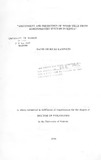| dc.description.abstract | The aim of the study was to assess and predict the growth and yield of wood in agroforestry areas of Embu District. The District was stratified into eight agro-ecological zones (AEZs) where a total of 14,746 trees were measured in 254 random farms. The species mostly investigated was Grevillea robusta .
G. robusta was the most common tree species occurring in majority of the AEZs and had an overall weighted frequency of 37% out of the 104 tree species found in the sampled farms. Frequencies of the other 103 tree species found in various farms ranged from 0.001 to 11.4%.
Planted trees accounted for 83% of all trees found in the farms and the number of trees planted per ha were positively related to the population density. High potential areas had more trees on farms than the low potential areas despite decreasing farm sizes. A spacing of 2.0 m was the most common for the trees which were not open grown. Boundary planting was the commonest pattern with a frequency of 42%.
The yield of G. robusta ranged from 0.007 to 0.025 m3/tree/year at ages three and six years respectively. Weighted mean volume of the species was 0.181 m3/tree. Biological rotation was 8, 9, 10,12,15 and 15 years for AEZs three, four, five, six, seven and eight respectively.
Farmers felled trees at an early age because of increasing demand for tree products and a need to reduce tree crop competition. Approximately 80% of G. robusta trees were harvested
before attaining 7 years which was below biological rotation. Corresponding diameters and heights were less than 17 cm and 12 metres respectively. Branch volume contributed an equivalent of about 26% of the stem volume.
G.robusta accounted for about 2.4 million trees with a volume of 440,000 nv in all AEZs. Stocking of planted trees ranged from zero to 65 trees per hectare in the eight agro-ecological zones while that of regeneration trees was generally low with ranges of 1 to 12.
The wood yield models for AEZ three to nine indicated that diameter, height, age, spacing, land slope and tree crown height were the important independent variables which influence wood yield in farms and they were significant at 0.05% probability level. Diameter was the most important independent variable which could be used to estimate tree volume with a precision level of 80%.
On validation, 57% of the sample plots indicated that there was no significant difference between observed and predicted volumes. Standard error of models ranged from 1.89 to 5.25% with a 95% confidence interval range of + 4.50 to 12.93%. | |

